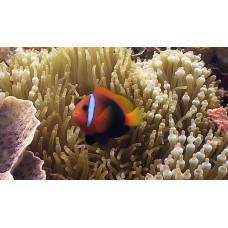Latin name
Amphiprion melanopus
Other name
Cinnamon clownfish, fire clownfish, red and black anemonefish, black-backed anemonefish, dusky anemonefish.
Identification
The scientific name "Melanopus" comes from the Greek and means "black legs" in reference to the black pelvic fins.
It is a consistent hermaphrodite with a strict dominance hierarchy based on size: the female is the largest, the breeding male is the second largest, and non-breeding males gradually decrease in size as the hierarchy descends. They exhibit protandry, meaning that when the only breeding female dies, the breeding male becomes a female and the breeding male becomes the largest of the non-breeding males.
Features of fish fins
Dorsal spines (total): 10; Dorsal soft rays (total): 16 - 18; Anal spines: 2; Anal soft rays: 13 - 14.
Fish colouring
The body of the Cinnamon Clownfish is dark red to orange with mahogany sides. Juveniles and adults have a broad white border that begins behind the eye and may have a blue tinge. The dorsal and caudal fins are lighter than the rest of the fish and can sometimes be cinnamon in color. The pelvic and anal fins are usually black.
Distribution
Cinnamon clownfish are widespread in the western Pacific, from the Great Barrier Reef north to the Marshall Islands and Guam, New Guinea, and from Vanuatu and New Caledonia to eastern Indonesia.
Habitat
A marine tropical species. Does not migrate. Depth range from 1 to 18 meters. Adults inhabit lagoons and outer reefs.
Size
Adult cinnamon clownfish can grow to 12 cm (4.7 inches). The reported maximum age is 5 years.
Behavior
The relationship between anemonefish and their host anemones is not random, but highly nested. A. melanopus is a generalist, usually hosted by 1 anemone, but also hosted by 2 other anemones. It is hosted by the following 3 out of 10 host anemones:
Entacmaea quadricolor - Bubble tip or purple base anemone (usually);
Heteractis crispa - Leathery anemone (occasionally);
Heteractis magnifica - Magnificent anemone (rare).
Food and feeding habits
This species is omnivorous and its diet is based on zooplankton, small bottom crustaceans and algae.
Reproduction
Spawns in benthos. Egg-laying, mating during reproduction. Eggs are on the bottom and adhere to the substrate. Males guard and aerate the eggs.
Fishing
These fish are harvested for sale in marine aquariums.
Relationship with a person
Harmless.
| Classification | |
| Phylum | Chordata |
| Class | Actinopterygii |
| Family | Pomacentridae |
| Genus | Amphiprion |
| Species | A. melanopus |
| Features | |
| Conservation status | Least Concern |
| Habitat | Pelagic |
| Life span, years | No information |
| Maximum body weight, kg | No information |
| Maximum length, cm | 12 |
| Sailing speed, m/s | No information |
| Threat to people | Not edible |
| Way of eating | Planktonophage |
Cinnamon clownfish
Tags: cinnamon clownfish



